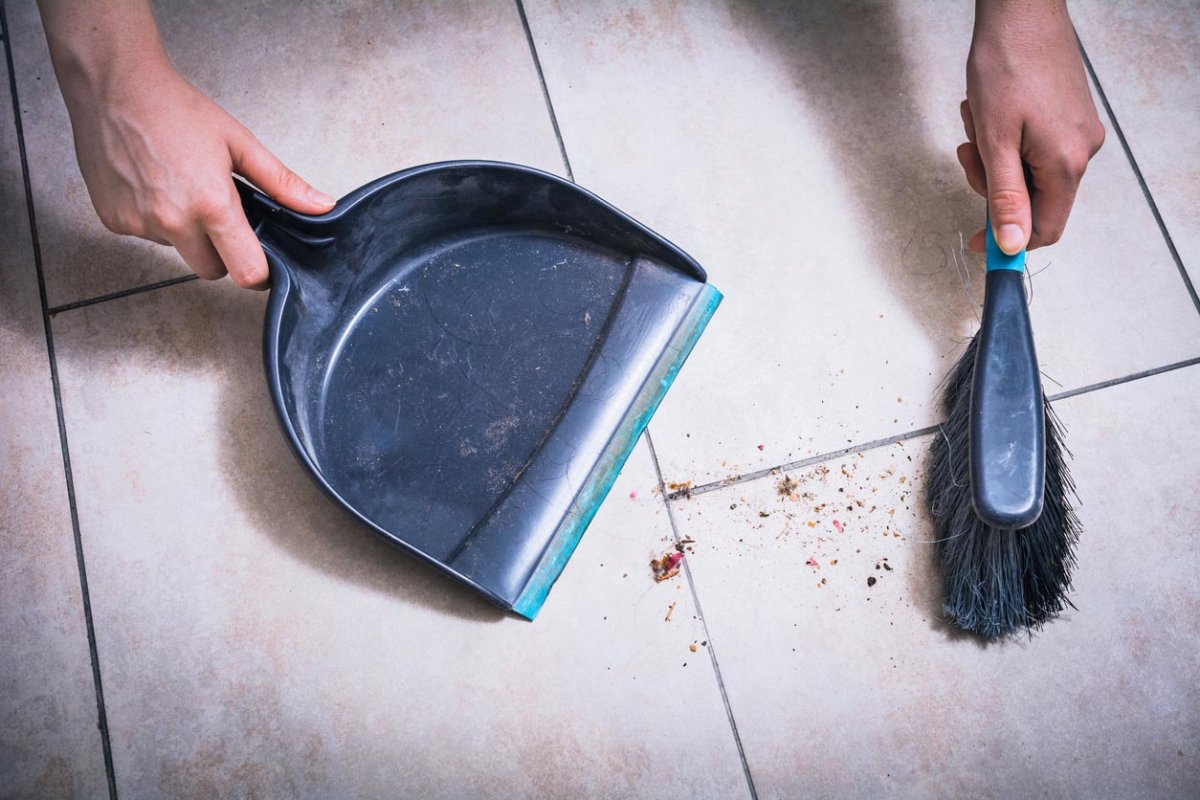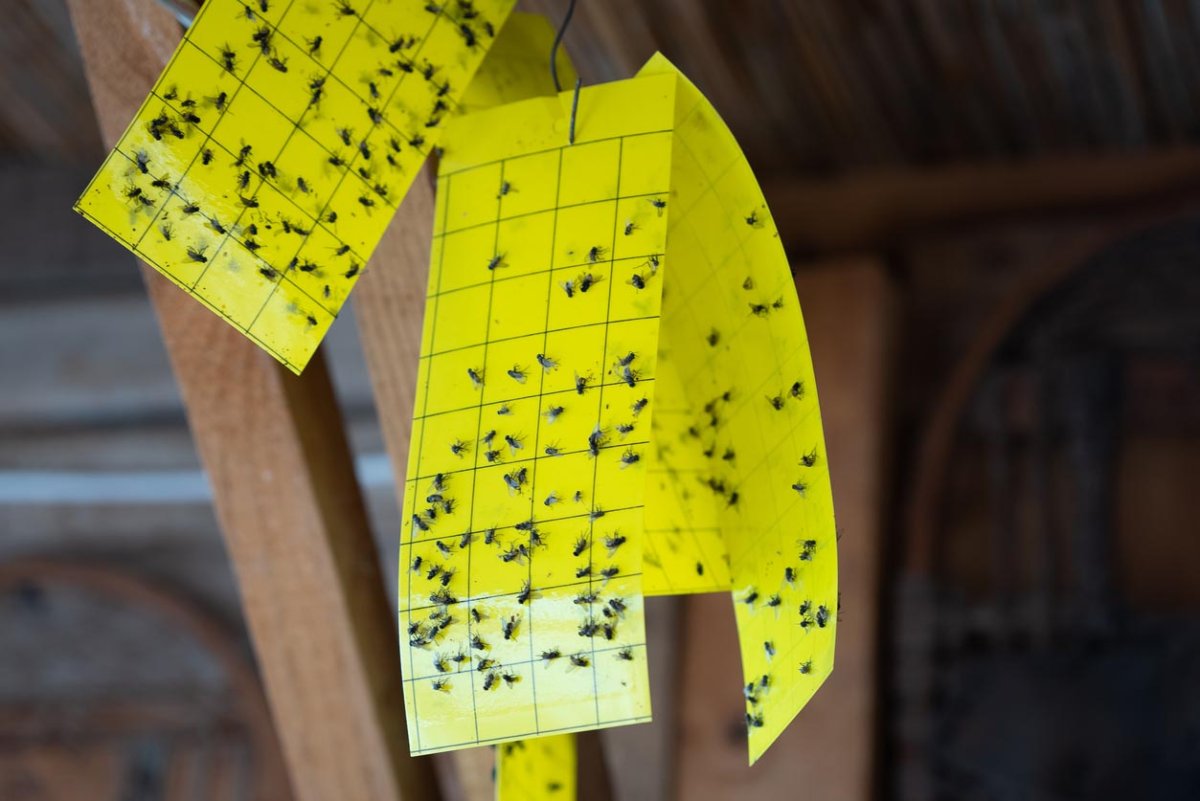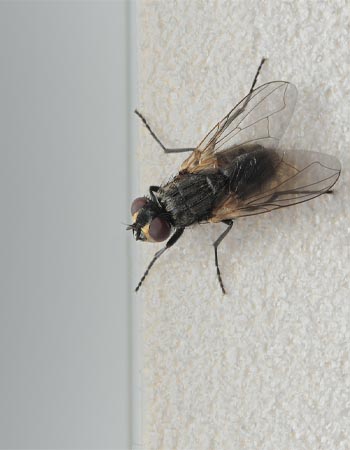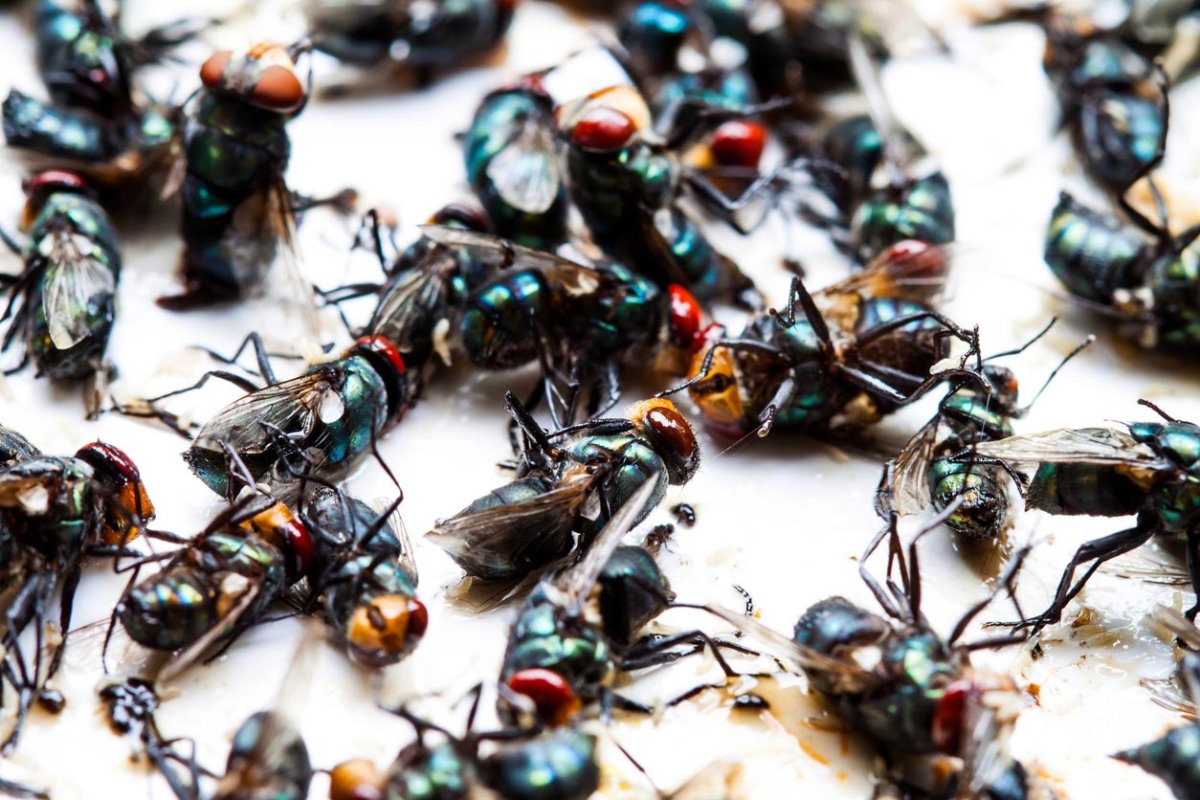We may earn revenue from the products available on this page and participate in affiliate programs. Learn More ›
What You Need to Know
- Phorid flies are a common summer pest that can reproduce at incredibly fast rates, making them difficult to get rid of.
- While phorid flies do not bite or present a significant health risk, they have the potential to spread disease-causing bacteria.
- Some of the most effective ways to get rid of phorid flies are identifying their source, cleaning up food scraps and crumbs, cleaning drains regularly, repairing leaks and sources of excess moisture, and using sticky traps or homemade fly traps.
- If DIY methods aren’t working, it’s worth it to have a pest control professional treat the home to remove phorid flies and prevent them from coming back.
In the warmer months, it’s not uncommon to find your indoor space disrupted by an unexpected guest: the phorid fly, also called the filth fly.
These tiny phorid flies, often mistaken for drain flies or black fruit flies, can become a significant nuisance quickly due to their fast reproduction rate. Although the phorid fly life cycle is typically less than a month, according to the Los Angeles County Department of Public Health, a female can lay up to 500 eggs in her lifetime.
Black phorid flies are often mistaken for fruit flies but have some subtle visual differences. For instance, phorid humpbacked flies are slightly smaller than fruit flies. They are even resistant to seasonal humidity and temperature changes, meaning they can appear in the home any time of the year. Understanding their appearance and behaviors can help facilitate the identification of phorid flies in your home. Once identified, it’s typically possible to eliminate phorid flies with a few simple steps, but a persistent infestation may be a job for one of the best pest control companies (like Orkin or Terminix).
Time required: 2 to 4 hours (may vary based on infestation severity)
Difficulty: Beginner
Tools & Materials
Bobvila.com may earn a commission from purchases made through these links.
- Bug zapper
- Protective gloves
- Scrub brush or sponge
- Drain snake
- Cleaning brush
- Small bowl or glass jar
- Plastic wrap
- Sticky traps
- Biological drain cleaner
- Fly repellent
- Drain cleaning solution
- Fly traps
- Apple cider vinegar
- Dish soap
Phorid flies are a major nuisance, Fortunately, it’s possible to learn how to get rid of phorid flies before they take over your home.
1. Identify the source of the phorid fly infestation.
Getting rid of phorid flies is similar to getting rid of gnats—it’s vital to figure out where the pests are coming from. First, inspect the home to locate the breeding sites of phorid flies. “When dealing with a positively identified phorid fly, we need to locate what is referred to as ‘thick water,’ says Thomas Olschewske, region technical training manager at Arrow Exterminators, a pest control service based in Atlanta, Georgia. “Thick water is stagnant water that has started growing thick, which can happen if you overwater indoor plants. It could also be caused by the A/C condensation pump in the basement not pumping out completely, or by a serious drainpipe problem. In the worst-case scenario, it could involve a dead animal in the walls, attic, or crawl space.”
Look for small, white phorid fly larvae or pupae, which indicate an active breeding site. It’s worth searching less obvious areas like cracks in plumbing, broken pipes, and any other damp spots, too. Phorid flies can thrive in hidden, hard-to-reach areas, such as beneath floor tiles or behind walls. Conduct a thorough investigation checking under and around appliances and fixtures.

2. Clean up any messes such as crumbs or spills that phorid flies could be feasting on.
It’s important to maintain a high level of cleanliness to prevent phorid fly infestations. Even the best fly repellents won’t be effective if you don’t address what is attracting flies in the first place. Clean all the kitchen surfaces, including countertops, sinks, and floors, and pay special attention to areas where food is prepared and consumed. Even the smallest crumbs can attract these pests. “Cleaning the area where the phorid flies are laying eggs will be most beneficial,” Richard adds.
Don’t forget to check and clean under large kitchen appliances such as refrigerators, stoves, and dishwashers, where crumbs and spills can accumulate unnoticed. Using a cleaning solution that effectively removes food residues and disinfects simultaneously will free the area of attractants. In addition to cleaning, be sure to quickly dispose of any food waste and keep garbage bins tightly sealed.
3. Carefully clean drains to remove organic matter that may be attracting phorid flies.
The smell of rotting food and organic materials in drains is a boon to phorid flies, and they often lay eggs in the built-up debris in drains. This is one reason phorid flies are commonly mistaken for drain flies, but drain flies have a fuzzy and even moth-like appearance. If you’re not sure which of these insects you have, drain cleaning is an effective way to eliminate either of these pests.
“The easiest thing homeowners can do is rinse out the garbage disposal after turning it off,” Olschewske advises. “Most homeowners agree with this statement, but when they ‘go through the motions,’ they realize they’re turning off the water before turning off the garbage disposal, which leads to organic buildup in the disposal.” Consider also using biological drain cleaners, which contain enzymes and bacteria and are particularly effective, as they digest organic material without harming plumbing. After the drain is treated, use a scrub brush to remove any remaining residue. If necessary, a plumber’s snake or a similar tool can be used to reach further into the pipes and dislodge stubborn debris. For stubborn clogs, consider calling one of the best drain cleaning services for assistance.
4. Identify and address moisture issues like plumbing leaks around the home, as these can become breeding grounds for phorid flies.
Regularly inspect the areas around sinks, pipes, and other plumbing fixtures for signs of leaks or moisture buildup. Phorid flies are attracted to the moist, organic matter found in these areas. Leaky pipes can also attract pests and will need to be repaired immediately. If any walls or other materials sustain water damage, replace them immediately to eliminate more potential breeding sites (not to mention mold growth).
If plumbing cracks or leaks create damp environments, phorid flies can originate from toilets within the home. Ensure that toilets function correctly and that seals around them are intact to prevent a standing water source. Significant plumbing issues will need to be addressed by one of the best plumbing services (such as Mr. Rooter or Roto-Rooter).

5. Purchase sticky traps to place in areas where phorid flies have been spotted.
Place phorid fly traps in areas where the pests have been spotted, such as near drains, garbage disposals, appliances, and other locations with high organic matter accumulation or potential breeding sites. Sticky traps work by attracting the flies with bait and capturing them on the adhesive surface.
Traps help reduce the adult fly population in the home and provide a clear indication of infestation hot spots. It’s a good idea to regularly check and replace the traps as needed to maintain their efficiency.
6. You can also use apple cider vinegar to make homemade fly traps.
It’s simple to make a homemade phorid fly trap by filling a small container like a bowl or glass jar with apple cider vinegar and a splash of dish soap, then covering it with plastic wrap that has a few small holes poked through it. The vinegar’s sweet smell attracts the flies, and once they enter the container, they become trapped. The dish soap breaks the surface tension of the water so flies can’t float and will drown in the liquid.
To maximize their effectiveness, place the homemade traps in areas where phorid flies have been spotted. Regularly empty and refill the traps to ensure they remain an effective solution to phorid fly problems. You can also purchase one of the best fly traps rather than making your own.
7. Consider hiring a pest control professional if DIY methods aren’t working.
It’s understandable to want to address a pest issue yourself to save on pest control costs. However, if DIY methods prove ineffective, it may be time to consider hiring a pest control professional. “Everyone’s threshold for pest infestations is different,” says Richard. “The trick is to manage the concern early by following sanitation practices. If these steps aren’t working and activity doesn’t decrease within a week, that is the time to call a pest professional.”
Professionals can thoroughly assess a phorid fly infestation and implement comprehensive treatment plans. With their expertise and tools, pest control professionals can identify hidden breeding sites that can be missed during a DIY inspection, such as broken pipes under floors or behind walls.
Hiring a pest control professional can save homeowners time and effort and provide access to specialized treatments and equipment that are not available to the general public. Professionals can also offer ongoing maintenance and prevention strategies to ensure that phorid flies do not return.
Before You Begin…

Anyone who knows how to get rid of fruit flies understands that keeping the home free of attractants like crumbs, spills, and other food scraps is key. This holds true for getting rid of phorid flies. “Phorid flies are attracted to wet, decaying matter such as mulch in landscapes as well as areas inside the home that retain moisture such as clogged drains, rotting fruit, and potted plant material,” says Trevor Richard, an associate certified entomologist at Fox Pest Control, a residential and commercial pest control company with locations across the U.S.
For those wondering whether phorid flies bite, the answer is no. Although phorid flies in the house are mostly just a nuisance, they do have the potential to spread disease-causing bacteria to food and surfaces, according to the Illinois Department of Public Health (IDPH). It’s best to remove them quickly to maintain a clean, comfortable home.
Tips for Getting Rid of Phorid Flies
- Since phorid flies are attracted to decaying organic matter, ensure all garbage disposals and drains are thoroughly cleaned. Any organic debris that could serve as a breeding ground will need to be removed.
- Regularly inspect and clean under kitchen appliances, around plumbing areas, and anywhere else that may harbor signs of moisture and organic debris. These are common sites where phorid flies lay eggs.
- Phorid flies are attracted to natural light and may congregate around lights at night. Residents can use one of the best bug zappers with lights or sticky traps with yellow backgrounds to leverage this attraction.
Safety Considerations
- Always wear protective gloves when handling cleaning agents and biological drain cleaners to prevent skin irritation and other adverse reactions.
- If using one of the best fly repellents, properly ventilate the space to avoid inhaling harmful chemicals. Keep in mind that aerosol sprays will only kill existing phorid flies and won’t address the problem at its source.


